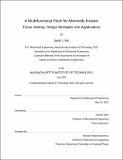A Multifunctional Patch for Minimally Invasive Tissue Sealing: Design Strategies and Applications
Author(s)
Wu, Sarah J.
DownloadThesis PDF (3.244Mb)
Advisor
Zhao, Xuanhe
Terms of use
Metadata
Show full item recordAbstract
Bioadhesive materials have garnered great attention due to their potential to replace sutures and staples during surgical procedures. Compared to the traditional mechanical sealing modalities, bioadhesive materials are generally associated with short application times and reduced tissue damage. However, the complexities of delivering bioadhesive materials through narrow spaces and achieving strong adhesion in fluid-rich physiological environments continue to present substantial limitations to the broader surgical translation of existing glues and sealants, particularly in the domain of minimally invasive surgery. This thesis presents the design and testing of a surgically implantable tissue-sealing patch for versatile minimally invasive wound-closing applications. The design approach is guided by the clinical needs to resist contamination caused by pre-exposure body fluids, achieve fast, strong, and fluid-tight tissue adhesion, and prevent postsurgical biofouling and inflammation. These criteria are realized through the synergistic integration of multiple distinct functional layers, including (1) a microtextured bioadhesive layer comprised of an interpenetrating NHS-grafted PAAc and biopolymer network, (2) a blood-repellent hydrophobic fluid layer infused into the microtextured bioadhesive layer, and (3) an antifouling zwitterionic polymer-interpenetrated elastomer backing. Strategies guiding the design and characterization of each layer are discussed, and tailored form factors for specific minimally invasive clinical applications are further demonstrated. This platform provides a basis for the future design of multifunctional, antifouling, and bioadhesive materials.
Date issued
2021-06Department
Massachusetts Institute of Technology. Department of Mechanical EngineeringPublisher
Massachusetts Institute of Technology